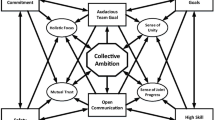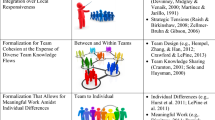Abstract
Knowledge-intensive work in modern global organisations is largely organised in teams or groups. Most of this work can be classified as knowledge creation with outcomes such as plans, contracts, proposals and analyses. Cooperating for knowledge-intensive work is recognised as a social process in which identification and organisational climate play an important role. Yet despite the mutual interdependence of members, their relations in teams are not necessarily closely knitted. Teams in multinational companies consist of members with different national, ethnic, functional and educational backgrounds, who are often situated at different locations, using a combination of means to communicate. These are not the most favourable conditions for an open way of exchanging knowledge and insights. On the other side, diversity in expertise is supposed to be a necessary condition for knowledge creation. It offers the requisite variety that is needed to cope with complex problems and the cognitive distance that is supposed to stimulate organisational learning. It is expected that identification of team members with their group can counterbalance the negative effects of diversity, while it can enforce the positive effect of task interdependence. This research is directed to the relations between social identification, diversity, interdependence and knowledge sharing in corporate teams. Social identification is an important issue since it is known as a builder of extra role behaviour in organisations. Diversity and interdependence are team features that shape the identification with a team. Social identification is considered as an important mediator between these independent variables and knowledge sharing as a dependent variable. The research has been carried out in a large beverage company with plants and agencies all over the world. A questionnaire has been used with validated scales. The research data stem from a sample of 169 respondents from 30 teams. A strong relation between knowledge sharing and social identification was found, while diversity of teams plays an intriguing role in stimulating and inhibiting knowledge sharing between team members.

Similar content being viewed by others
References
Ardichvili AP and Wentling T (2003) Motivation and barriers to participation in virtual knowledge-sharing communities of practice. Journal of Knowledge Management 7 (1), 64–77.
Baron RM and Kenny DA (1986) The moderator mediator variable distinction in social psychological-research – conceptual, strategic, and statistical considerations. Journal of Personality and Social Psychology 51 (6), 1173–1182.
Bijlsma K, Rosendaal BW and Bunt G vd (2005) Can trust breed heed? Differential effects of trust on heed and performance in a network and a divisional form of organizing. In Trust Under Pressure (BIJLSMA-FRANKEMA KM, Ed), pp 206–231, Edward Elgar, Chettenham.
Bogenrieder I and Nooteboom B (2004) Learning groups: what types are there? A theoretical analysis and an empirical study in a consultancy firm. Organization Studies 25 (2), 287–313.
Boisot MH (1995) Information Space: A Framework for Learning in Organizations, Institutions and Cultures. Routledge, London.
Brown JS and Duguid P (2001) Knowledge and organization: a social-practice perspective. Organization Science 12 (2), 198–213.
Brown SL and Eisenhardt KM (1995) Product development – past research, present findings, and future-directions. Academy of Management Review 20 (2), 343–378.
Cabrera EF and Cabrera A (2005) Fostering knowledge sharing through people management practices. International Journal of Human Resource Management 16 (5), 720–735.
Campion MA, Medsker GJ and Higgs AC (1993) Relations between work group characteristics and effectiveness – implications for designing effective work groups. Personnel Psychology 46 (4), 823–850.
Child J (1994) The Role of Social Identity in the International Transfer of Knowledge Through Joint Venture. Cambridge Judge Institute of Management Studies, Cambridge.
Cohen SG and Bailey DE (1997) What makes teams work: group effectiveness research from the shop floor to the executive suite. Journal of Management Accounting Research 23 (3), 239–290.
Coleman JS (1990) Foundations of Social Theory. Harvard University Press, Cambridge.
Creed WED and Miles RE (1996) Trust in organizations: a conceptual framework linking organizational forms, managerial philosophies, and the opportunity costs of controls. In Trust in Organizations: Frontiers of Theory and Research (TYLER R, Ed), pp 16–38, Sage, Thousand Oaks, CA.
Cummings JN (2004) Work groups, structural diversity, and knowledge sharing in a global organization. Management Science 50 (3), 352–364.
Edmondson AC (1999) Psychological safety and learning behavior in work teams. Administrative Science Quarterly 44 (2), 350–383.
Edmondson AC (2002) The local and variegated nature of learning in organizations: a group-level perspective. Organization Science 13 (2), 128–146.
Edmondson AC, Winslow AB, Bohmer RMJ and Pisano GP (2003) Learning how and learning what: effects of tacit and codified knowledge on performance improvement following technology adoption. Decision Sciences 34 (2), 197–223.
Ellemers N, De Gilder D and Haslam SA (2004) Motivating individuals and groups at work: a social identity perspective on leadership and group performance. Academy of Management Review 29 (3), 459–478.
Faraj S and Sproull L (2000) Coordinating expertise in software development teams. Management Science 46 (12), 1554–1568.
Fiol CM (1994) Consensus, diversity, and learning in organizations. Organization Science 5 (3), 403–420.
Fiol CM and O’Connor EJ (2005) Identification in face-to-face, hybrid, and pure virtual teams: untangling the contradictions. Organization Science 16 (1), 19–32.
Gherardi S and Nicolini D (2000) To transfer is to transform: the circulation of safety knowledge. Organization 7 (2), 329–348.
Gibson CB and Gibbs JL (2006) Unpacking the concept of virtuality: the effects of geographic dispersion, electronic dependence, dynamic structure, and national diversity on team innovation. Administrative Science Quarterly 51, 451–495.
Hobman EV, Bordia P and Gallois C (2003) Consequences of feeling dissimilar from others in a work team. Journal of Business and Psychology 17 (3), 301–325.
Hofstede G (1980) Culture's Consequences. Sage Publications, London.
Hsiu-Fen Lin GGL (2006) Effects of socio-technical factors on organizational intention to encourage knowledge sharing. Management Decision 44 (1), 74–89.
Jehn KA, Northcraft GB and Neale MA (1999) Why differences make a difference: a field study of diversity, conflict, and performance in workgroups. Administrative Science Quarterly 44 (4), 741–763.
Kogut B and Zander U (1996) What firms do? Coordination, identity, and learning. Organization Science 7 (5), 502–518.
Kramer R (1991) Intergroup relations and organizational dilemmas: the role of categorization processes. Research in Organizational Behavior 13, 191–228.
Mathieu JE and Taylor SR (2007) A framework for testing meso-mediational relationships in organizational behavior. Journal of Organizational Behavior 28 (2), 141–172.
Michailova S and Hutchings K (2006) National cultural influences on knowledge sharing: a comparison of China and Russia. Journal of Management Studies 43 (3), 383–405.
Milliken FJ and Martins LL (1996) Searching for common threads: understanding the multiple effects of diversity in organizational groups. Academy of Management Review 21 (2), 402–433.
Nahapiet J and Goshal S (1998) Social capital, intellectual capital, and the organizational advantage. Academy of Management Review 23 (2), 242–266.
Nonaka I (1994) A dynamic theory of organizational knowledge creation. Organization Science 5 (1), 14–37.
Nooteboom B (2000) Learning by interaction: absorptive capacity, cognitive distance and governance. Journal of Management and Governance 4 (1/2), 69–92.
Osterloh M and Frey BS (2000) Motivation, knowledge transfer, and organizational forms. Organization Science 11 (5), 538–550.
Podsakoff PM, Paine JB and Bachrach DG (2000) Organizational citizenship behaviors: a critical review of the theoretical and empirical literature and suggestions for future research. Journal of Management 26 (3), 513–563.
Rico RC and Cohen SG (2005) Effects of task interdependence and type of communication on performance in virtual teams. Journal of Managerial Psychology 20 (3/4), 261–274.
Rosendaal BW (2006) Learning cycles in knowledge intensive organizations: an exploratory study of the nature and dimensions of knowledge development in four departments. Knowledge Management Research & Practice 4 (4), 261–274.
Schulz M (2001) The uncertain relevance of newness: organizational learning and knowledge flows. Academy of Management Journal 44 (4), 661–681.
Shapiro DL, Furst SA, Spreitzer GM and Von Glinow MA (2002) Transnational teams in the electronic age: are team identity and high performance at risk? Journal of Organizational Behavior 23 (4), 455–467.
Sole D and Edmondson A (2002) Situated knowledge and learning in dispersed teams. British Journal of Management 13 (special issue 2), S17–S34.
Szulanski G (1996) Exploring internal stickiness: impediments to the transfer of best practice within the firm. Strategic Management Journal 17, 27–43.
Van den Hooff B and De Leeuw van Weenen F (2004) Committed to share: commitment and CMC use as antecedents of knowledge sharing. Knowledge and Process Management 11 (2), 13–24.
Van der Vegt G and Bunderson JS (2005) Learning and performance in multidisciplinary teams: the importance of collective team identification. Academy of Management Journal 48 (3), 532–547.
Van der Vegt G and Van de Vliert E (2000) Team members’ affective responses to patterns of intragroup interdependence and job complexity. Journal of Management 26 (4), 633–655.
Van der Vegt G and Van de Vliert E (2002) Intragroup interdependence and effectiveness: review and proposed directions for theory and practice. Journal of Managerial Psychology 17 (1/2), 50–67.
Van der Vegt G and Van de Vliert E (2005) Effects of perceived skill dissimilarity and task interdependence on helping in work teams. Journal of Management 31 (1), 73–89.
Van der Zee K, Atsma N and Brodbeck F (2004) The influence of social identity and personality on outcomes of cultural diversity in teams. Journal of Cross-Cultural Psychology 35 (3), 283–303.
Van Knippenberg D (2000) Work motivation and performance: a social identity perspective. Applied Psychology – An International Review 49 (3), 357–371.
Van Knippenberg D, De Dreu C and Homan AC (2004) Work group diversity and group performance: an integrative model and research agenda. Journal of Applied Psychology 89 (6), 1008–1022.
Von Krogh G (1998) Care in knowledge creation. California Management Review 40 (3), 133–154.
Wageman R (1995) Interdependence and group effectiveness. Administrative Science Quarterly 40 (1), 145–180.
Weick KE and Roberts KH (1993) Collective mind in organizations – heedful interrelating on flight decks. Administrative Science Quarterly 38 (3), 357–381.
Wuyts S, Dutta S and Nooteboom B (2005) Empirical tests of optimal cognitive distance. Journal of Economic Behavior & Organization 58 (2), 277–302.
Zarraga C and Bonache J (2005) The impact of team atmosphere on knowledge outcomes in self-managed teams. Organization Studies 26 (5), 661–681.
Zellmer-Bruhn M and Gibson C (2006) Multinational organization context: implications for team learning and performance. Academy of Management Journal 49 (3), 501–518.
Author information
Authors and Affiliations
Corresponding author
Rights and permissions
About this article
Cite this article
Rosendaal, B. Sharing knowledge, being different and working as a team. Knowl Manage Res Pract 7, 4–14 (2009). https://doi.org/10.1057/kmrp.2008.32
Received:
Accepted:
Published:
Issue Date:
DOI: https://doi.org/10.1057/kmrp.2008.32




